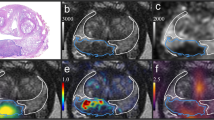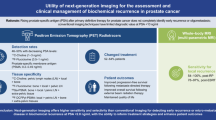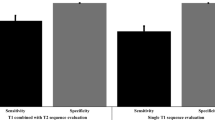Key Points
-
Accurate prostate cancer diagnosis and staging is crucial to plan the most appropriate and tailored treatment
-
Serum PSA level can identify disease, but not localize the site of local and distant disease
-
Conventional morphological imaging modalities, such as transrectal ultrasonography (TRUS), CT, and MRI, are associated with some limitations in staging prostate cancer
-
Morphofunctional imaging, such as PET–CT, which provides molecular characterization of prostate cancer, could overcome some of the limitations of conventional imaging modalities
-
Choline-PET–CT represents the most established whole-body molecular imaging modality for prostate cancer diagnosis and staging
Abstract
An early and correct diagnosis together with accurate staging of prostate cancer is necessary in order to plan the most appropriate treatment strategy. Morphological imaging modalities such as transrectal ultrasonography (TRUS), CT, and MRI can have some limitations regarding their accuracy for primary diagnosis and staging of prostate cancer; for instance, they have limited specificity in differentiating cancer from benign prostatic conditions and, by using size as the only criterion to characterize lymph node metastases, they might not be accurate enough for tumour characterization. In this scenario, PET–CT with 11C-labelled or 18F-labelled choline derivatives provides morphological and functional characterization and could overcome the limitations of the conventional imaging techniques. PET–CT is one of the most investigated molecular imaging modalities for prostate cancer diagnosis and staging. Currently, the main investigations on the role of PET–CT in the diagnosis and staging of prostate cancer have been performed on a retrospective basis and this type of analysis might be one of the main reasons why different results regarding its diagnostic accuracy have been reported.
This is a preview of subscription content, access via your institution
Access options
Subscribe to this journal
Receive 12 print issues and online access
$209.00 per year
only $17.42 per issue
Buy this article
- Purchase on Springer Link
- Instant access to full article PDF
Prices may be subject to local taxes which are calculated during checkout



Similar content being viewed by others
References
Heidenreich, A. et al. EAU guidelines on prostate cancer. part 1: screening, diagnosis, and local treatment with curative intent-update 2013. Eur. Urol. 65, 124–137 (2014).
Hovels, A. M. et al. The diagnostic accuracy of CT and MRI in the staging of pelvic lymph nodes in patients with prostate cancer: a meta-analysis. Clin. Radiol. 63, 387–395 (2008).
Kwee, S. A., Coel, M. N., Lim, J. & Ko, J. P. Prostate cancer localization with 18fluorine fluorocholine positron emission tomography. J. Urol. 173, 252–255 (2005).
Picchio, M. et al. Imaging biomarkers in prostate cancer: role of PET/CT and MRI. Eur. J. Nucl. Med. Mol. Imaging 42, 644–655 (2015).
Murphy, R. C., Kawashima, A. & Peller, P. J. The utility of 11C-choline PET/CT for imaging prostate cancer: a pictorial guide. AJR Am. J. Roentgenol. 196, 1390–1398 (2011).
Kitajima, K., Murphy, R. C. & Nathan, M. A. Choline PET/CT for imaging prostate cancer: an update. Ann. Nucl. Med. 27, 581–591 (2013).
Farsad, M. et al. Detection and localization of prostate cancer: correlation of (11)C-choline PET/CT with histopathologic step-section analysis. J. Nucl. Med. 46, 1642–1649 (2005).
Yamaguchi, T. et al. Prostate cancer: a comparative study of 11C-choline PET and MR imaging combined with proton MR spectroscopy. Eur. J. Nuc. Med. Mol. Imaging 32, 742–748 (2005).
Martorana, G. et al. 11C-choline positron emission tomography/computerized tomography for tumor localization of primary prostate cancer in comparison with 12-core biopsy. J. Urol. 176, 954–960 (2006).
Reske, S. N. et al. Imaging prostate cancer with 11C-choline PET/CT. J. Nucl. Med. 47, 1249–1254 (2006).
Piert, M. et al. Detection of aggressive primary prostate cancer with 11C-choline PET/CT using multimodality fusion techniques. J. Nucl. Med. 50, 1585–1593 (2009).
Van den Bergh, L. et al. Is there an additional value of 11C-choline PET/CTto T2-weighted MRI images in the localization of intraprostatic tumor nodules? Int. J. Radiat. Oncol. Biol. Phys. 83, 1486–1492 (2012).
Souvatzoglou, M. et al. The sensitivity of [11C]choline PET/CT to localize prostate cancer depends on the tumor configuration. Clin. Cancer Res. 17, 3751–3759 (2011).
Kotzerke, J. et al. Experience with carbon-11 choline positron emission tomography in prostate carcinoma. Eur. J. Nucl. Med. 27, 1415–1419 (2000).
Scher, B. et al. Value of 11C-choline PET and PET/CT in patients with suspected prostate cancer. Eur. J. Nucl. Med. Mol. Imaging 34, 45–53 (2007).
Sutinen, E. et al. Kinetics of [(11)C]choline uptake in prostate cancer: a PET study. Eur. J. Nucl. Med. Mol. Imaging 31, 317–324 (2004).
de Jong, I. J., Pruim, J., Elsinga, P. H., Vaalburg, W. & Mensink, H. J. Visualization of prostate cancer with 11C-choline positron emission tomography. Eur. Urol. 42, 18–23 (2002)
Yoshida, S., Nakagomi, K., Goto, S., Futatsubashi, M. & Torizuka, T. 11C-choline positron emission tomography in prostate cancer: primary staging and recurrent site staging. Urol. Int. 74, 214–220 (2005).
Giovacchini, G. et al. [(11)C]choline uptake with PET/CT for the initial diagnosis of prostate cancer: relation to PSA levels, tumour stage and anti-androgenic therapy. Eur. J. Nucl. Med. Mol. Imaging 35, 1065–1073 (2008).
Igerc, I. et al. The value of 18F-choline PET/CT in patients with elevated PSA-level and negative prostate needle biopsy for localisation of prostate cancer. Eur. J. Nuc.l Med. Mol. Imaging 35, 976–983 (2008).
Brogsitter, C., Zophel, K. & Kotzerke, J. (18)F-Choline, (11)C-choline and (11)C-acetate PET/CT: comparative analysis for imaging prostate cancer patients. Eur. J. Nucl. Med. Mol. Imaging 40 (Suppl. 1), S18–S27 (2013).
Testa, C. et al. Prostate cancer: sextant localization with MR imaging, MR spectroscopy, and 11C-choline PET/CT. Radiology 244, 797–806 (2007).
Watanabe, H. et al. Preoperative detection of prostate cancer: a comparison with 11C-choline PET, 18F-fluorodeoxyglucose PET and MR imaging. J. Magn. Reson. Imaging 31, 1151–1156 (2010).
Briganti, A. et al. Updated nomogram predicting lymph node invasion in patients with prostate cancer undergoing extended pelvic lymph node dissection: the essential importance of percentage of positive cores. Eur. Urol. 61, 480–487 (2012).
Hricak, H., Choyke, P. L., Eberhardt, S. C., Leibel, S. A. & Scardino, P. T. Imaging prostate cancer: a multidisciplinary perspective. Radiology 243, 28–53 (2007).
Hovels, A. M. et al. The diagnostic accuracy of CT and MRI in the staging of pelvic lymph nodes in patients with prostate cancer: a meta-analysis. Clin. Radiol. 63, 387–395 (2008).
Jager, G. J., Barentsz, J. O., Oosterhof, G. O., Witjes, J. A. & Ruijs, S. J. Pelvic adenopathy in prostatic and urinary bladder carcinoma: MR imaging with a three-dimensional TI-weighted magnetization-prepared-rapid gradient-echo sequence. AJR Am. J. Roentgenol. 167, 1503–1507 (1996).
Oyen, R. H. et al. Lymph node staging of localized prostatic carcinoma with CT and CT-guided fine-needle aspiration biopsy: prospective study of 285 patients. Radiology 190, 315–322 (1994).
Tiguert, R. et al. Lymph node size does not correlate with the presence of prostate cancer metastasis. Urology 53, 367–371 (1999).
Heesakkers, R. A. et al. MRI with a lymph-node-specific contrast agent as an alternative to CT scan and lymph-node dissection in patients with prostate cancer: a prospective multicohort study. Lancet Oncol. 9, 850–856 (2008).
de Jong, I. J., Pruim, J., Elsinga, P. H., Vaalburg, W. & Mensink, H. J. Preoperative staging of pelvic lymph nodes in prostate cancer by 11C-choline PET. J. Nucl. Med. 44, 331–335 (2003).
Hacker, A. et al. Detection of pelvic lymph node metastases in patients with clinically localized prostate cancer: comparison of [18F]fluorocholine positron emission tomography-computerized tomography and laparoscopic radioisotope guided sentinel lymph node dissection. J. Urol. 176, 2014–2018 (2006).
Husarik, D. B. et al. Evaluation of [(18)F]-choline PET/CT for staging and restaging of prostate cancer. Eur. J. Nucl. Med. Mol. Imaging 35, 253–263 (2008).
Contractor, K. et al. Use of [11C]choline PET-CT as a noninvasive method for detecting pelvic lymph node status from prostate cancer and relationship with choline kinase expression. Clin. Cancer Res. 17, 7673–7683 (2011).
Schiavina, R. et al. 11C-choline positron emission tomography/computerized tomography for preoperative lymph-node staging in intermediate-risk and high-risk prostate cancer: comparison with clinical staging nomograms. Eur. Urol. 54, 392–401 (2008).
Beheshti, M. et al. 18F choline PET/CT in the preoperative staging of prostate cancer in patients with intermediate or high risk of extracapsular disease: a prospective study of 130 patients. Radiology 254, 925–933 (2010).
Kwee, S. A. et al. Use of step-section histopathology to evaluate 18F-fluorocholine PET sextant localization of prostate cancer. Mol. Imaging 7, 12–20 (2008).
Evangelista, L., Guttilla, A., Zattoni, F. & Muzzio, P. C. Utility of choline positron emission tomography/computed tomography for lymph node involvement identification in intermediate-to high-risk prostate cancer: a systematic literature review and meta-analysis. Eur. Urol. 63, 1040–1048 (2013).
Poulsen, M. H. et al. [18F]-fluorocholine positron-emission/computed tomography for lymph node staging of patients with prostate cancer: preliminary results of a prospective study. BJU Int. 106, 639–643 (2010).
Poulsen, M. H. et al. [18F]fluoromethylcholine (FCH) positron emission tomography/computed tomography (PET/CT) for lymph node staging of prostate cancer: a prospective study of 210 patients. BJU Int. 110, 1666–1671 (2012).
Umbehr, M. H., Muntener, M., Hany, T., Sulser, T. & Bachmann, L. M. The role of 11C-choline and 18F-fluorocholine positron emission tomography (PET) and PET/CT in prostate cancer: a systematic review and meta-analysis. Eur. Urol. 64, 106–117 (2013).
Calabria, F., Chiaravalloti, A., Tavolozza, M., Ragano-Caracciolo, C. & Schillaci, O. Evaluation of extraprostatic disease in the staging of prostate cancer by F-18 choline PET/CT: can PSA and PSA density help in patient selection? Nucl. Med. Commun. 34, 733–740 (2013).
von Eyben, F. E. & Kairemo, K. Meta-analysis of (11)C-choline and (18)F-choline PET/CT for management of patients with prostate cancer. Nucl. Med. Commun. 35, 221–230 (2014).
Evangelista, L., Cimitan, M., Zattoni, F., Guttilla, A. & Saladini, G. Comparison between conventional imaging (abdominal-pelvic computed tomography and bone scan) and [F]choline positron emission tomography/computed tomography imaging for the initial staging of patients with intermediate-to high-risk prostate cancer: A retrospective analysis. Scand. J. Urol. http://dx.doi.org/10.3109/21681805.2015.1005665.
Fuccio, C., Rubello, D., Castellucci, P., Marzola, M. C. & Fanti, S. Choline PET/CT for prostate cancer: Main clinical applications. Eur. J. Radiol. 80, e50–e56 (2011).
Eschmann, S. M. et al. Comparison of 11C-choline-PET/CT and whole body-MRI for staging of prostate cancer. Nuklearmedizin 46, 161–168 (2007).
Beer, A. J. et al. Restricted water diffusibility as measured by diffusion-weighted MR imaging and choline uptake in (11)C-choline PET/CT are correlated in pelvic lymph nodes in patients with prostate cancer. Mol. Imaging Biol. 13, 352–361 (2011).
Budiharto, T. et al. Prospective evaluation of 11C-choline positron emission tomography/computed tomography and diffusion-weighted magnetic resonance imaging for the nodal staging of prostate cancer with a high risk of lymph node metastases. Eur. Urol. 60, 125–130 (2011).
Heck, M. M. et al. Prospective comparison of computed tomography, diffusion-weighted magnetic resonance imaging and [(11)C]choline positron emission tomography/computed tomography for preoperative lymph node staging in prostate cancer patients. Eur. J. Nucl. Med. Mol. Imaging 41, 694–701 (2014).
Vag, T. et al. Preoperative lymph node staging in patients with primary prostate cancer: comparison and correlation of quantitative imaging parameters in diffusion-weighted imaging and 11C-choline PET/CT. Eur. Radiol. 24, 1821–1826 (2014).
Gandaglia, G. et al. Distribution of metastatic sites in patients with prostate cancer: A population-based analysis. Prostate 74, 210–216 (2014).
Fuccio, C. et al. Role of 11C-choline PET/CT in the re-staging of prostate cancer patients with biochemical relapse and negative results at bone scintigraphy. Eur. J. Radiol. 81, e893–e896 (2012).
Segall, G. M. PET/CT with Sodium 18F-Fluoride for Management of Patients with Prostate Cancer. J. Nucl. Med. 55, 531–533 (2014).
Poulsen, M. H. et al. Spine Metastases in Prostate Cancer: Comparison of [Tc]MDP whole-body Bone Scintigraphy, [(18)F]Choline PET/CT, and [(18)F]NaF PET/CT. BJU Int. 114, 818–823 (2013).
Picchio, M. et al. [11C]Choline PET/CT detection of bone metastases in patients with PSA progression after primary treatment for prostate cancer: comparison with bone scintigraphy. Eur. J. Nucl. Med. Mol. Imaging 39, 13–26 (2012).
Beheshti, M. et al. The use of F-18 choline PET in the assessment of bone metastases in prostate cancer: correlation with morphological changes on CT. Mol. Imaging Biol. 11, 446–454 (2009).
Tuncel, M. et al. [(11)C]Choline positron emission tomography/computed tomography for staging and restaging of patients with advanced prostate cancer. Nucl. Med. Biol. 35, 689–695 (2008).
Schuster, D. M. et al. Initial experience with the radiotracer anti-1-amino-3-18F-fluorocyclobutane-1-carboxylic acid with PET/CT in prostate carcinoma. J. Nucl. Med. 48, 56–63 (2007).
Schuster, D. M. et al. Characterization of primary prostate carcinoma by anti-1-amino-2-[(18)F]-fluorocyclobutane-1-carboxylic acid (anti-3-[(18)F] FACBC) uptake. Am. J. Nucl. Med. Mol. Imaging 3, 85–96 (2013).
Schuster, D. M. et al. Detection of recurrent prostate carcinoma with anti-1-amino-3-18F-fluorocyclobutane-1-carboxylic acid PET/CT and 111In-capromab pendetide SPECT/CT. Radiology 259, 852–861 (2011).
Afshar-Oromieh, A. et al. PET imaging with a [68Ga]gallium-labelled PSMA ligand for the diagnosis of prostate cancer: biodistribution in humans and first evaluation of tumour lesions. Eur. J. Nucl. Med. Mol. Imaging 40, 486–495 (2013).
Eder, M., Eisenhut, M., Babich, J. & Haberkorn, U. PSMA as a target for radiolabelled small molecules. Eur. J. Nucl. Med. Mol. Imaging 40, 819–823 (2013).
Afshar-Oromieh, A. et al. Comparison of PET imaging with a (68)Ga-labelled PSMA ligand and (18)F-choline-based PET/CT for the diagnosis of recurrent prostate cancer. Eur. J. Nucl. Med. Mol. Imaging 41, 11–20 (2014).
Afshar-Oromieh, A. et al. PET/MRI with a Ga-PSMA ligand for the detection of prostate cancer. Eur. J. Nucl. Med. Mol. Imaging 41, 887–897 (2014).
Jadvar, H. PSMA PET in Prostate Cancer. J. Nucl. Med. http://dx.doi.org/10.2967/jnumed.115.157339.
Souvatzoglou, M. et al. Comparison of integrated whole-body [11C]choline PET/MR with PET/CT in patients with prostate cancer. Eur. J. Nucl. Med. Mol. Imaging 40, 1486–1499 (2013).
Souvatzoglou, M. et al. PET/MR in prostate cancer: technical aspects and potential diagnostic value. Eur. J. Nucl. Med. Mol. Imaging 40 (Suppl. 1), S79–S88 (2013).
Ratib, O. PET/MRI: a new era in multimodality molecular imaging. Clin. Transl. Imaging 1, 5–10 (2013).
Pace, L., Nicolai, E., Aiello, M., Catalano, O. A. & Salvatore, M. Whole-body PET/MRI in oncology: current status and clinical applications. Clin. Transl. Imaging 1, 31–44 (2013).
Panebianco, V. et al. Conventional imaging and multiparametric magnetic resonance (MRI, MRS, DWI, MRP) in the diagnosis of prostate cancer. Q. J. Nucl. Med. Mol. Imaging 56, 331–342 (2012).
Lord, M., Ratib, O. & Vallee, J. P. 18F-Fluorocholine integrated PET/MRI for the initial staging of prostate cancer. Eur. J. Nucl. Med. Mol. Imaging 38, 2288 (2011).
de Perrot, T. et al. Potential of hybrid 18F-fluorocholine PET/MRI for prostate cancer imaging. Eur. J. Nucl. Med. Mol. Imaging 41, 1744–1755 (2014).
Author information
Authors and Affiliations
Contributions
P.M. researched data for and wrote the article, both authors reviewed and edited the article before submission
Corresponding author
Ethics declarations
Competing interests
The authors declare no competing financial interests.
Rights and permissions
About this article
Cite this article
Mapelli, P., Picchio, M. Initial prostate cancer diagnosis and disease staging—the role of choline-PET–CT. Nat Rev Urol 12, 510–518 (2015). https://doi.org/10.1038/nrurol.2015.191
Published:
Issue Date:
DOI: https://doi.org/10.1038/nrurol.2015.191
This article is cited by
-
Novel non-MRI imaging techniques for primary diagnosis of prostate cancer: micro-ultrasound, contrast-enhanced ultrasound, elastography, multiparametric ultrasound, and PSMA PET/CT
Prostate Cancer and Prostatic Diseases (2024)
-
Genomic and Phenotypic Biomarkers for Precision Medicine Guidance in Advanced Prostate Cancer
Current Treatment Options in Oncology (2023)
-
Examining the influence of illness perception and financial toxicity on the quality of life of prostate cancer patients
African Journal of Urology (2021)
-
18F-DCFPyL PET/CT in primary staging of prostate cancer
European Journal of Hybrid Imaging (2018)
-
A population-based study of the clinical utility of 18F–choline PET/CT for primary metastasis staging of high-risk prostate cancer
European Journal of Hybrid Imaging (2017)



